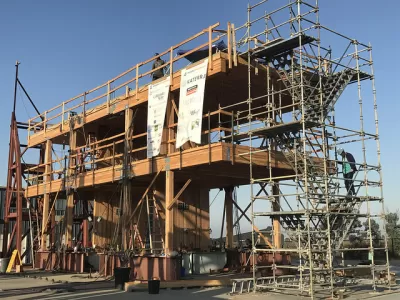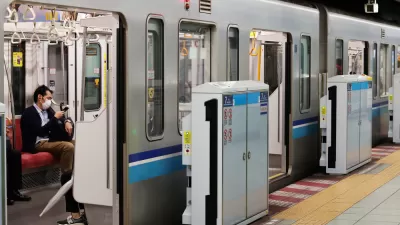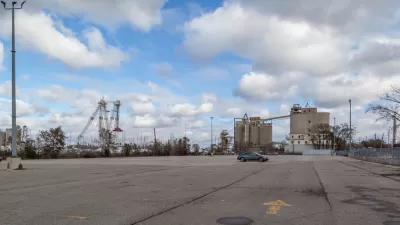Quayside, Sidewalk Labs' smart city in Toronto, calls for ten tall buildings made entirely of wood. Here's why proponents think mass timber is a good idea, and what obstacles stand in its way.

"In most U.S. cities, mass timber buildings, and specifically tall mass timber buildings, are a rarity, if they exist at all," Kira Barrett writes. But Sidewalk Labs' ambitious plan for a Toronto smart city called Quayside includes plans for ten of them. Barrett discusses the nature of the building material, which often consists of cross-laminated timber (CLT) panels, and its pros and cons.
To begin with the positives, proponents cite mass timber's capacity for carbon sequestration: one advocacy organization argues that a site with no building at all has a higher carbon footprint than one with a CLT structure. Mass timber buildings also weigh less than concrete and steel, reducing risk during seismic events.
But several factors hold mass timber back, the most obvious being the perception that wooden buildings are more prone to fire damage (even though engineered wood such as CLT mitigates some of that risk). There's also the question of access to timber for cities far from forests, the need to build out CLT production facilities, and a general lack of familiarity with the material on the part of architects and designers.
Its novelty means mass timber isn't included in the International Building Code, meaning that "construction with this material currently involves years of research, development and testing to make special state and city exceptions, on top of the already intensive construction process."
FULL STORY: Sidewalk Labs is building a smart city entirely of mass timber. What could go wrong?

Planetizen Federal Action Tracker
A weekly monitor of how Trump’s orders and actions are impacting planners and planning in America.

Maui's Vacation Rental Debate Turns Ugly
Verbal attacks, misinformation campaigns and fistfights plague a high-stakes debate to convert thousands of vacation rentals into long-term housing.

Restaurant Patios Were a Pandemic Win — Why Were They so Hard to Keep?
Social distancing requirements and changes in travel patterns prompted cities to pilot new uses for street and sidewalk space. Then it got complicated.

In California Battle of Housing vs. Environment, Housing Just Won
A new state law significantly limits the power of CEQA, an environmental review law that served as a powerful tool for blocking new development.

Boulder Eliminates Parking Minimums Citywide
Officials estimate the cost of building a single underground parking space at up to $100,000.

Orange County, Florida Adopts Largest US “Sprawl Repair” Code
The ‘Orange Code’ seeks to rectify decades of sprawl-inducing, car-oriented development.
Urban Design for Planners 1: Software Tools
This six-course series explores essential urban design concepts using open source software and equips planners with the tools they need to participate fully in the urban design process.
Planning for Universal Design
Learn the tools for implementing Universal Design in planning regulations.
Heyer Gruel & Associates PA
JM Goldson LLC
Custer County Colorado
City of Camden Redevelopment Agency
City of Astoria
Transportation Research & Education Center (TREC) at Portland State University
Jefferson Parish Government
Camden Redevelopment Agency
City of Claremont




























